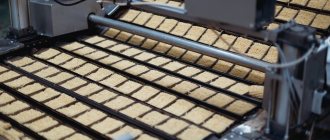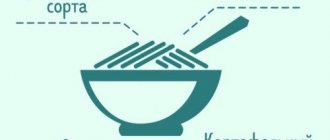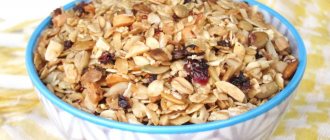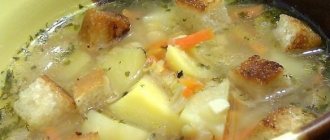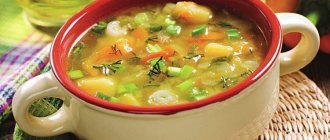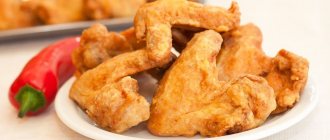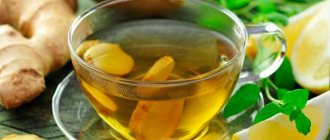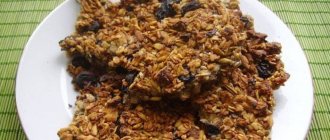Most residents of Russia and other post-Soviet countries are confident that eating fast food is harmful. And this is true, because such products contain large quantities of fats, carbohydrates, and harmful additives that improve the appearance, aroma and taste of the products.
The benefits and harms of Doshirak instant noodles are also the cause of constant controversy and debate. In this article we will try to figure out whether Doshirak has any benefits and what is the harm of this noodle.
When participating in the “Update with Doshirak” campaign, as well as in all other promotions carried out by this company, willy-nilly you have to buy packages of noodles and register the codes that are under the packaging. You will find answers to questions about this promotion in our article. Many people want to receive prizes and gifts, but what to do with noodles? After all, many argue that it is very harmful and should not be eaten. But let's figure out whether noodles really contain harmful ingredients that are harmful to health or whether these are idle speculations of ordinary people.
What are instant noodles?
The noodles in question originated in ancient China. Then the famous chef tried to fry pasta in fat, so that in emergency cases he could cook it faster. But the recipe didn’t take root. It became truly popular only a few centuries later.
In the middle of the last century, a Japanese culinary specialist began improving the recipe. He managed to create a fast, convenient, cheap and tasty product that instantly won the love of millions of consumers. To date, its composition has changed somewhat, but the principle of preparation remains the same.
Initially, the product was conceived as an ideal food option for soldiers during the war, but eventually it began to be sold in peacetime.
Instant noodles are a product that undergoes preliminary heat treatment in several stages. For example, pasta is steamed and also fried in hot vegetable oil.
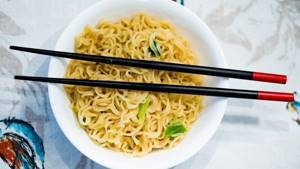
They are sold dried. To prepare the product, you just need to add boiling water and wait a few minutes. Therefore, it has become the optimal lunch option for those who need to quickly and easily prepare food in the field.
How to cook noodles
In order to cook noodles correctly, you must first carefully read the instructions on the package. After reading the tips, you need to boil water and pour in the noodles, which should already be in a thermal container or food container. Pre-purchased products can be crushed and then poured with boiling water. Then cover the contents and leave in this state for 5-6 minutes. During this time, prepare additional products that are intended for a hearty duet with Doshirak brand noodles. When the allotted time has expired, the lid must be opened and the resulting side dish must be thoroughly mixed. Experienced specialists and lovers of such food recommend serving noodles with broth, based on the belief that this way they cool down more slowly.
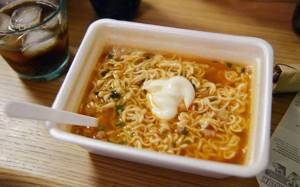
Chemical composition and energy value
The composition of Doshirak noodles includes:
- wheat flour (high-grade);
- starch thickener;
- salt (can be either rock or iodized) and beet sugar;
- vegetable fat;
- dried white onion and dried kelp (powder);
- soybean oil;
- emulsifiers and stabilizers;
- yeast (or rather, its extract).
These components are included precisely in the composition of the noodles themselves. Nutritionists note that in general it does not contain any harmful dangerous ingredients. But at the same time, the product cannot be called useful. Due to the high content of white flour that has undergone multiple purification, such noodles can be classified as “carbohydrate dummies.” It is high in calories and saturates the body quickly but not for long.
Only powdered kelp has a beneficial effect on its work. It saturates the body with iodine. Although its dose in one serving of noodles is insignificant, it allows manufacturers to position their product as healthy in advertising.
Unfortunately, today manufacturers do not note that, of all the oils for frying noodles, they often choose palm oil. It is the most inexpensive of all plant foods, but the most harmful. When heated during frying, such oil breaks down into trans fats and then turns into a real poison for the body.
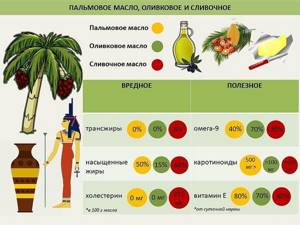
Ingredients of the seasoning broth:
- salt (in increased quantities);
- broth base (it usually includes dry vegetables, meat powder, spices, flavorings, soy sauce);
- monosodium glutamate;
- sugar;
- acidity regulators;
- sugar color – dye;
- guar gum – thickener;
- maltodextrin.
Its more precise composition depends on the chosen flavor. Of all the ingredients in seasoning broth, it is worth knowing about monosodium glutamate. This additive does not have its own taste, but enhances the taste of other products with which it is combined. It is harmless to the human body only in the most minimal quantities. The BJU of the product will also depend on the specific type of Doshirak.
If we talk about one of the most popular product options - beef-flavored noodles, then the indicators will be as follows:
| BJU | Value in g (per 100 g) |
| Squirrels | 7 |
| Fats | 19 |
| Carbohydrates | 62 |
What components in Doshirak are not harmful?
So, we know the composition of Doshirak, let’s now see what won’t harm us.
- Modified starch contains useful and even necessary substances for humans: sodium, magnesium, potassium, monosaccharides, dietary fiber. There is no harm in it, but like all genetically modified products, it can pose a potential threat. Modified starch is added to foods as a thickener, and can be found in products such as sauces, mayonnaise, sour cream, sweets, ice cream, jellies and other products.
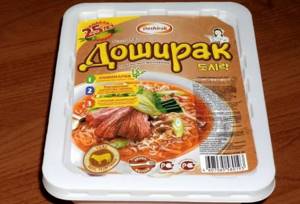
- Kelp powder is a well-known seaweed that contains iodine. There is little of it in noodles, so you can’t expect much benefit, but no harm either.
- Gluten, which serves to impart elasticity and maintain shape, as well as the elasticity of the finished product, is not considered harmful. However, it may not be suitable for some due to individual intolerance to the product.
- A packet containing herbs and soy meat. There is practically nothing harmful in it.
- Dried onions, garlic, ginger - prepared on the basis of natural products, do not pose any harm, unless you have chronic gastritis, which can become acute when using grains of dried spicy products.
How many calories in finished form?
Doshirak's calorie content in its finished form is quite high, so you should include it in your menu with extreme caution. This indicator also changes depending on what flavor and additives the noodles are chosen with.
The table will help you understand the calorie content of different product options:
| Noodles flavor: | Calorie content |
| Pork | 463 |
| Bacon | 398 |
| Beef | 442 |
| Seafood | 402 |
| Chicken | 459 |
| Gribov | 444 |
| Kimchi | 441 |
In this extensive list, the leader in calorie content was the popular noodles from Doshirak called “Chan Ramen” - 472 kcal. And the minimum indicator for Premium noodles is 352. These data are relevant for the product in a ready-made form (steamed with boiling water).
Production process
Doshirak (calorie content in its finished form was discussed above) is produced according to the following scheme:
- First, a simple dough is kneaded, the main ingredient of which is premium wheat flour. Previously, the latter is carefully sifted in special installations and combined with additional components. Additives make the noodles denser and more elastic. The dough is also kneaded not by hand, but in a special machine. During the process, water and salt are added to the flour, but in a minimal amount so that the dough does not lose its elasticity.
- The resulting mass after kneading (for 17-20 minutes) is left to “rest”. This process takes approximately 6-7 minutes.
- Next, the dough is rolled out thinly. Rolling waves take on this task. The layers entering them are 1 cm thick, and the layers coming out are 1 mm thick.
- Afterwards the prepared dough is cut into noodles. Doshirak's is wavy, so a special technology is used here. On a special machine, the dough ribbon moves along 2 waves at once. Their speeds are different. One is slower, so the dough slows down and curls.
- At the next stage, the dough pieces are steamed.
- Only after this the noodles are fried using oil.
- Lastly, the finished product is dried, packaged and packaged.

The main stage of the described production is heat treatment. Approximately 4-5 min. The already cut noodles are continuously doused with steam. The temperature of the latter is exactly 100°. Unlike cooking in water, when treated with steam, the product does not lose its shape and does not absorb excess water. Therefore, in the future it can be stored much longer.
After steaming, the starch is washed off from the noodles. For this procedure, salt water is used - a powerful jet of liquid that does not have time to be absorbed into the product. Next, the noodles are thoroughly soaked in vegetable oil (most often palm oil) and cut into briquettes, in which buyers then see them in packages on store shelves.
At the last stage of heat treatment, the product is distributed into miniature frying pans and deep-fried.
Here, technologists strictly adhere to all parameters - 4 min. at 150°, otherwise the product may burn quickly. This kind of roasting “seals” the product and allows it to be stored for up to 10-12 months.
After the last stage of heat treatment, the noodles are dried and cooled. Its temperature should be from 27 to 33°. The finished product is placed in plastic plates, containers or bags. But before that, it undergoes quality control to check for defects.
Before final packaging, various additives are laid out in the container with noodles - dry spices, vegetables, sauces, broths. Sometimes the instant product also comes with individually wrapped plastic cutlery.
Beneficial features
Doshirak, the calorie content of which in finished form ranges from 350 to 372 kcal, does not bring any benefit to the human body.
Among the advantages of this product are:
- quickly satisfy hunger (but for a short period);
- simplicity and convenience of preparation;
- the presence of a plate and fork included (in some product variants);
- bright taste.
At the same time, regular consumption of Doshirak noodles can seriously harm your health.
general information

This food has a spicy taste. This property is explained by the presence of a large number of spices, such as red pepper. In the process of preparing Doshirak noodles with beef, an aromatic additive is used. It gives the dish a characteristic meaty taste. The product is produced in plastic packaging, which contains a bag of spices and broth seasoning. The pack also contains a small disposable fork.
Contraindications and possible harm
The harm of instant noodles is explained primarily by its composition:
- a large amount of salt increases blood pressure, retains fluid in the body, and negatively affects the condition of bones and joints;
- monosodium glutamate can cause addiction, as well as a pseudo-allergic reaction characteristic of food intolerance;
- artificial flavors and dyes increase the risk of cancer and atherosclerosis;
- a high glycemic index increases the risk of developing diabetes, and also causes a feeling of extreme hunger after 60-90 minutes;
- a high-calorie product increases appetite;
- palm oil increases the level of “bad” cholesterol, which can lead to strokes and heart attacks;
- trans fats disrupt the absorption of nutrients into cell membranes and can lead to the development of atherosclerosis.
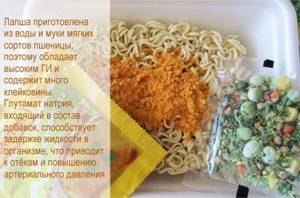
Doshirak in finished form, in addition, disrupts the functioning of the gastrointestinal tract and can provoke the development of gastritis, peptic ulcers, and colitis. And its high calorie content contributes to rapid weight gain.
It is strictly forbidden to eat such a product if:
- any pathologies of the stomach and intestines;
- obesity;
- serious diseases of the cardiovascular system;
- gout, arthritis, arthrosis.
It is also not recommended to add instant noodles to your diet for children, pregnant women and nursing mothers.
Using the brand name in everyday life
The high popularity of the product, as well as its low cost, led to the fact that various statements related to the brand name began to appear among the people. Questions began to appear: “Working for bread” what is it? How to understand the statement “a startup on the market” or “there is not enough money on the market?” Such phrases describe situations in which a person or organization has a minimum wage level that is sufficient for survival.
Also in the stories of the writer O. Robski, there was a mention of the use of Doshirak by the heroines together with other inexpensive products of relatively low quality. Which, according to critics, is used to strengthen the role of the writer as an arbitrator between elite citizens and poor people.
Features of use in childhood and pregnant women
Doshirak is especially harmful to children and pregnant women for the following reasons:
- Excess salt is especially difficult for the body of the expectant mother and child to tolerate, immediately leading to swelling, the appearance of bags under the eyes, and can also cause irreparable harm to the salt and water balance in the body.
- The composition of the product is aggressive to the mucous membranes of the digestive system and can cause an inflammatory process.
- Promotes rapid weight gain and disrupts metabolism, to which children and women are especially susceptible during pregnancy.
Additives such as acidity regulators (eg sodium acetate, acetic acid and calcium lactate). If consumed frequently, they irritate the mucous membranes of the stomach and intestines. Some parents give their kids Doshirak, hoping to feed them beef or chicken, which is declared as an ingredient, which they do not want to eat in their usual dishes.

But recent research by Rospotrebnadzor has proven that real meat is not added to the product under discussion. Manufacturers use only soybeans. The youngest members of the family and expectant mothers should try to completely exclude instant noodles from their diet.
Now let’s take a closer look at the additives with index E used in noodles.
Emulsifier E322 - Lecithin is a substance found in the human body, and without which the normal functioning of the brain and the entire nervous system as a whole is impossible.
Lecithin restores damaged cells, ensures the transport of vitamins and minerals to the cells of the body. Stabilizer E501i - Potassium carbonate - a white crystalline substance, highly soluble in water. Low toxicity, belongs to hazard class III. Not much, but still toxic.
Stabilizer E412 - Guar gum - a consistency stabilizer, is almost not absorbed in the intestines, reduces appetite and very effectively reduces the level of cholesterol and other fats.
Stabilizer E452i - sodium polyphosphate.
How to use on a diet
Doshirak in its finished form has the highest calorie content, so you definitely won’t be able to lose weight by making such a product the main one on your menu. When people talk about the “pre-cancer diet,” it is rather a humorous expression that denotes a difficult period in life, during which you have to save a lot on food.
As a result, the diet turns out to be not only very high in calories, but also harmful to health.
On average, the calorie content of 100 g of finished noodles is 400 kcal. This is already an impressive figure, and, as a rule, mayonnaise and other sauces, bread, sausages, and sausage are added to a portion of such a dish. As a result, one plate for lunch or dinner (especially for men) can reach up to 900 kcal. If you eat such a dish several times a day, the caloric value will be critical.
In general, occasionally allowing yourself a serving of instant noodles is not prohibited.
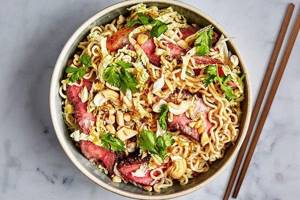
But at the same time, you need to cook only pasta, pouring boiling water over it. All included sauces, spices and other additives should be removed, since they contain the main harmful components. For example, it is permissible to cook 100 g of noodles for lunch, adding regular salt, pepper and other spices to taste.
In addition to this dish, it is best to choose stewed vegetables - zucchini, tomatoes, onions. They will replace the high-calorie sauce that is dangerous for your figure. You can also add pieces of boiled chicken or beef, grilled seafood, canned corn or green peas to your serving.
Doshirak noodles in their finished form have a high calorie content, and also contain components that can cause serious harm to human health - especially a child or expectant mother. Therefore, you should include them in your menu with extreme caution.

